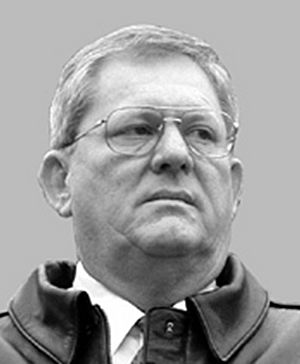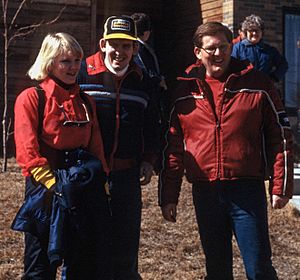Bill Janklow facts for kids
Quick facts for kids
Bill Janklow
|
|
|---|---|

From 2003's Congressional Pictorial Directory
|
|
| 27th and 30th Governor of South Dakota | |
| In office January 7, 1995 – January 3, 2003 |
|
| Lieutenant | Carole Hillard |
| Preceded by | Walter Dale Miller |
| Succeeded by | Mike Rounds |
| In office January 1, 1979 – January 6, 1987 |
|
| Lieutenant | Lowell Hansen |
| Preceded by | Harvey Wollman |
| Succeeded by | George S. Mickelson |
| Member of the U.S. House of Representatives from South Dakota's at-large district |
|
| In office January 3, 2003 – January 20, 2004 |
|
| Preceded by | John Thune |
| Succeeded by | Stephanie Herseth Sandlin |
| 25th Attorney General of South Dakota | |
| In office January 3, 1975 – January 1, 1979 |
|
| Governor | Richard Kneip Harvey Wollman |
| Preceded by | Kermit Sande |
| Succeeded by | Mark Meierhenry |
| Personal details | |
| Born |
William John Janklow
September 13, 1939 Chicago, Illinois, U.S. |
| Died | January 12, 2012 (aged 72) Sioux Falls, South Dakota, U.S. |
| Resting place | Black Hills National Cemetery |
| Political party | Republican |
| Spouse | Mary Dean Thom |
| Education | University of South Dakota (BS, JD) |
| Military service | |
| Allegiance | |
| Branch/service | |
| Years of service | 1956–1959 |
| Rank | Private First Class |
| Unit | 3rd Marine Division |
| Battles/wars | Second Taiwan Strait Crisis |
| Awards | 823 Badge of Honor (Taiwan) |
William John Janklow (September 13, 1939 – January 12, 2012) was an American lawyer and politician. He was a member of the Republican Party. Janklow holds the record for serving the longest as Governor of South Dakota, with sixteen years in office. He was also the third-longest serving governor in U.S. history.
Janklow served as the 25th Attorney General of South Dakota from 1975 to 1979. After that, he became the state's 27th Governor from 1979 to 1987. He then served again as the 30th Governor from 1995 to 2003. Later, Janklow was elected to the United States House of Representatives. He served there for just over a year. He resigned in 2004 after a serious car accident.
Contents
Early Life and Education
Janklow was born in Chicago, Illinois. When he was 10 years old, his father passed away. His mother then moved the family back to the United States. In 1954, when Janklow was 15, they settled in Flandreau, South Dakota.
In 1955, Janklow had some trouble and ended up in court. A judge gave him a choice: go to a reform school or join the military. Janklow chose the military. He left high school and joined the U.S. Marine Corps in 1956.
Military Service
Janklow went through basic training at Camp Pendleton, California. He was trained as a personnel clerk. He was then sent to the 3rd Marine Division in Okinawa, Japan. He was part of a group of Marines who helped during the 1958 Quemoy-Matsu crisis. This was an international event.
Janklow was shot in the leg while delivering cannons to Taiwanese troops. He received an honorable discharge in 1959. He was a private first class. In 1999, the government of Taiwan gave Janklow the 823 Badge of Honor. This award remembers the Quemoy-Matsu conflict.
College Years
After leaving the Marines, Janklow started attending the University of South Dakota. The school found out he didn't have a high school diploma. Janklow convinced them to let him stay if he kept good grades. He succeeded and graduated in 1964. He earned a Bachelor of Science degree in business administration.
Legal Career
Janklow continued his education at the University of South Dakota School of Law. He earned a law degree (J.D.) in 1966. After law school, he worked as a lawyer for six years. He helped people on the Rosebud Indian Reservation. He eventually became the director of the program there.
In 1973, he was appointed as a chief prosecutor. He also became the chief of litigation in the South Dakota Attorney General's Office. He quickly became known as a top trial lawyer.
Serving as Attorney General
In 1974, Janklow was chosen by the Republican Party to run for attorney general. He won the election. He served as the Attorney General from 1975 to 1979.
During his time as Attorney General, he argued two important cases. These cases were heard before the United States Supreme Court. One case was South Dakota v. Opperman. The other was Rosebud Sioux Tribe v. Kneip. In Opperman, Janklow successfully argued that police could search a car that was towed for a parking ticket. In Rosebud, he successfully argued about federal laws. These laws had changed the size of the Rosebud Indian Reservation. This was done without following old treaties.
First Term as Governor

Janklow was first elected governor in 1978. He was easily reelected in 1982. He won with 70.9 percent of the vote. This was the highest percentage ever for a governor in the state.
Before he took office, a tax on personal property was removed. This tax helped fund local governments. So, the state government had to find new ways to get money. Governor Janklow worked with the legislature to replace the lost tax income. They created a new tax for contractors. They also changed the tax on banks. A better economy also helped the state get more money.
In 1979, Janklow signed a law that brought back the death penalty in South Dakota. Another change that year was to close the state's Department of Environmental Protection. This was because of its role in efforts by the Sioux to stop development in the Black Hills. Janklow also supported a law to remove South Dakota's limit on interest rates. This change attracted banks to the state. For example, Citibank opened a credit card center in Sioux Falls.
Railroad Improvements
When the Milwaukee Railroad went out of business, Janklow called a special meeting of the legislature. The state bought the main part of the old railroad. The state then leased this property to the Burlington Northern railroad. This helped keep important railway shipping for many goods in the state. Janklow also worked to make public places easier for people with disabilities to use.
U.S. Senate Race
State law prevented Janklow from running for governor again in 1986. So, he decided to challenge the current U.S. Senator James Abdnor. This was in the Republican primary election. Janklow lost this race. Abdnor won by a 55 percent to 45 percent margin. This primary battle was thought to make Abdnor weaker. This may have led to Abdnor losing the general election to Democrat Tom Daschle.
Second Term as Governor
Janklow returned to politics in 1994. He won the Republican primary for governor. He easily won the general election that year. He was reelected in 1998. In his second two terms, he cut property taxes for homes and farms by 30 percent. He was able to make up for the lost money. This was because voters had removed the inheritance tax.
Janklow is the longest-serving governor in South Dakota history. He was the only person in the state's history to serve eight full years as governor, which he did twice. Since then, Mike Rounds and Dennis Daugaard have also served two full terms as governor.
U.S. House of Representatives
In 2002, Janklow ran for the Republican nomination for South Dakota's only House seat. He won against the Democratic candidate, Stephanie Herseth.
Car Accident and Resignation
On August 16, 2003, Janklow was in a serious car accident. He failed to stop at an intersection near Trent, South Dakota. His car hit a motorcyclist named Randy Scott. Scott, who was 55, died instantly. Janklow's car traveled a long distance after the crash. He suffered a broken hand and bleeding in his brain.
Investigators found that Janklow was driving faster than the speed limit. He also ran a stop sign where the crash happened. Janklow said he was very sorry for the accident. His lawyers said he had low blood sugar. They said this made him confused. Janklow testified that he had taken an insulin shot and not eaten that day. Medical experts said this could cause disorientation.
An accident expert estimated Janklow's speed was 63 or 64 miles per hour. The Highway Patrol had estimated his speed as at least 70 mph. The expert also said Scott's motorcycle might have been going up to 65 mph. The Highway Patrol had estimated 59 mph.
Janklow had a history of traffic stops. The superintendent of the state highway patrol said Janklow had 16 traffic stops as governor. He was not given tickets for these. This was due to respect for his position. Two troopers testified they had stopped Janklow for speeding over 80 mph. They gave him warnings instead of tickets.
On December 8, 2003, a jury found Janklow responsible for the accident. He was also found responsible for speeding, running a stop sign, and reckless driving. A month later, he resigned from Congress. This was effective January 20, 2004. On January 22, Janklow was sentenced to 100 days in jail. After 30 days, he could leave jail for community service. He was released on May 17, 2004.
Scott's family sued Janklow for damages. However, the court ruled that Janklow was on official business. So, he was protected from personal financial claims. The government was responsible instead. In July 2006, Scott's family sued the U.S. government for $25 million. The lawsuit was settled for $1 million on May 14, 2008.
Later Life and Passing
After January 5, 2006, Janklow was allowed to practice law again. He worked as an attorney. In spring 2006, he was hired to work against a railroad expansion. He also represented landowners. These landowners wanted money from the railroad for using their property.
On November 4, 2011, Janklow announced he had terminal brain cancer. He passed away at a hospice in Sioux Falls on January 12, 2012. He was 72 years old. Governor Dennis Daugaard ordered flags across the state to be flown at half staff. Janklow was buried at Sturgis, South Dakota's Black Hills National Cemetery.
Images for kids


